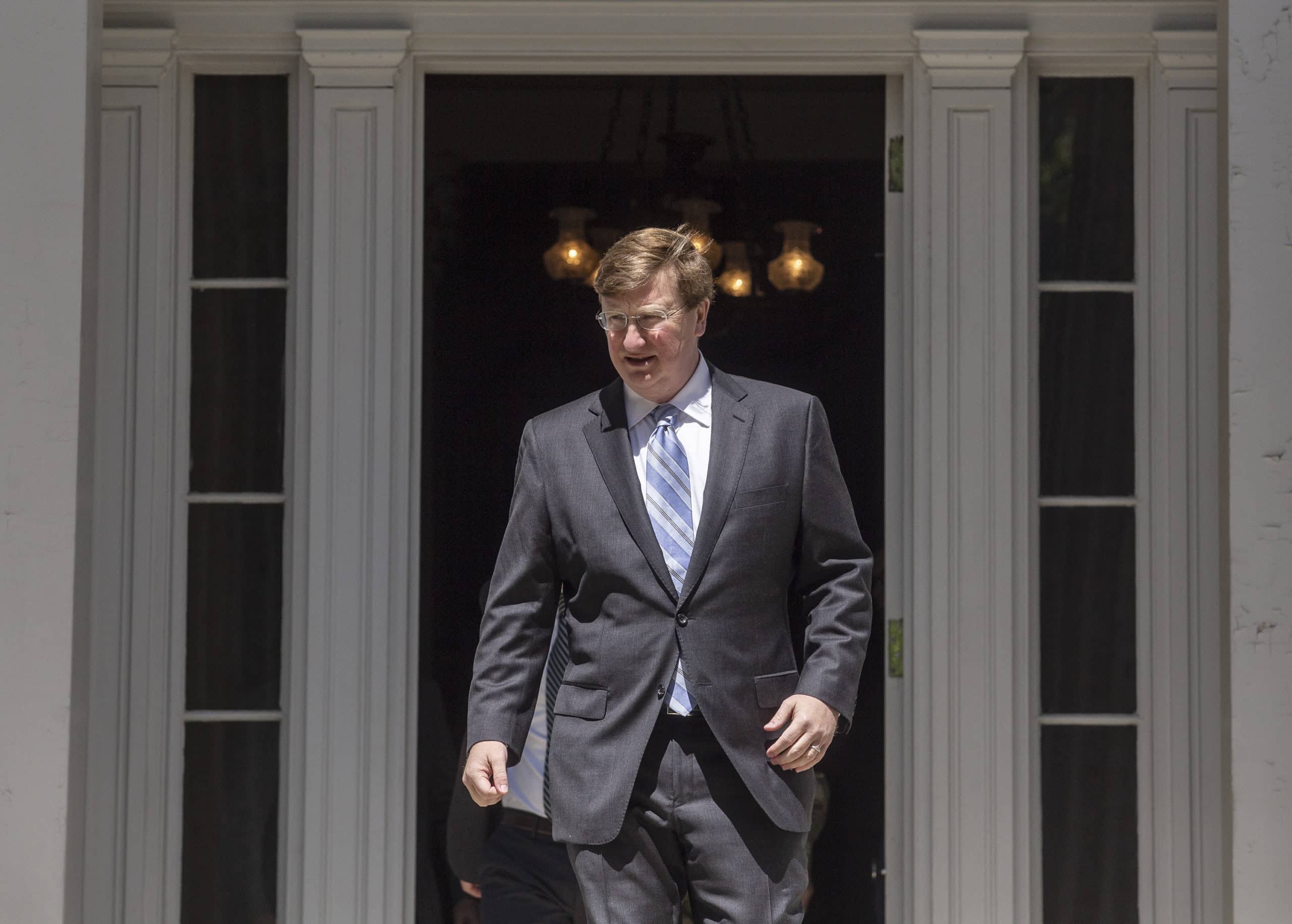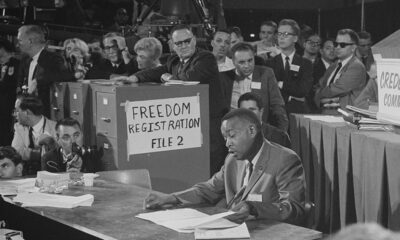Mississippi Today
Gov. Tate Reeves’ lonely last stand against Medicaid expansion

One year ago, Gov. Tate Reeves continued his years of steadfast defiance against Medicaid expansion and delivered a plea to his fellow Republican legislative leaders.
“Don’t simply cave under the pressure of Democrats and their allies in the media who are pushing for the expansion of Obamacare, welfare, and socialized medicine,” Reeves said in his January 2023 State of the State address. “You have my word that if you stand up to the left’s push for endless government-run healthcare, I will stand with you.”
Later today, Reeves will again deliver his annual State of the State address. But this year, he will be standing mostly alone in that fight. It very well could be his final stand.
Much to the governor’s chagrin, the very GOP legislative leaders he pleaded with last year are well underway this year in their push to pass Medicaid expansion — a policy that would have a profound effect on countless Mississippians, their families and their communities. Yes, there are a handful of anti-expansion Republicans in both the House and Senate, but whether Reeves can whip anywhere close to the number of votes needed to block it is in real question.
Medicaid expansion, which Republican Lt. Gov. Delbert Hosemann and Republican House Speaker Jason White are ushering this session, would provide health coverage to between 200,000 and 250,000 poor, working Mississippians and bring in more than $1 billion in additional federal funds to the state each year.
Proponents say the policy would save the lives and livelihoods of countless Mississippians and provide hospitals with a cash boon that could help them keep their doors open. Opponents such as Reeves have decried the policy as “welfare expansion” and, despite dozens of economic studies that say otherwise, maintain the state cannot afford the state match.
Last week, the two legislative leaders — and the Medicaid committee chairs they appointed — remained unmoved by Reeves’ criticism about their pursuit of the policy.
“My position’s been pretty clear on the fact that we were going to explore and look at Medicaid as it affects hard-working, low-income Mississippians,” House Speaker Jason White told Mississippi Today. “My ideas and thoughts about that haven’t changed. He’s the duly elected governor and he’s certainly entitled to his opinions on that matter. I don’t hold any of those against him. We just maybe here in the House have a different view of it.”
No matter how hard Reeves fights back, the GOP legislative leaders pushing an expansion plan this year are not caving to Democrats or the media. They are seeking to help Mississippians of all backgrounds who have long struggled to keep their families healthy. They are responding to small town hospital leaders and business owners who are begging for a life-saving shot in the arm. They are trying to create solutions for our state’s dismal labor participation rate. They are modeling the success of 40 others states — including many GOP-controlled — where Medicaid expansion has unequivocally saved lives.
And, without question, many of the lawmakers know Medicaid expansion is a wildly popular public policy.
The vast majority of Mississippians want it. Business leaders want it, mayors want it, and hospital leaders want it. Republican voters want it, and Democratic voters want it. Big-time Republican donors want it. Health care organizations like the Mississippi State Medical Association, Mississippi Hospital Association, American Cancer Society, and the American Heart Association want it. A majority of legislative Republicans want it, and all legislative Democrats want it. The Republican lieutenant governor wants it, and the Republican speaker wants it.
But Tate Reeves doesn’t. And his last-stand defiance could define his legacy.
The governor has more policy staffers inside the Capitol this year than in his first term, and whether they can convince enough GOP lawmakers to stand with the governor could become the biggest question of the 2024 legislative session.
If legislative leaders do advance and pass an expansion proposal as expected, Reeves could veto the bill. To override his veto would require a two-thirds vote of both the House and the Senate chambers. The mad scramble to whip and wrangle votes during those few days would be unmatched by any legislative moment of Reeves’ governorship.
Many Capitol observers will be listening intently to the governor’s State of the State speech Monday evening. Hosemann and White will be sitting closely behind the governor’s podium, and how they respond to any renewed pleas or perhaps even attacks on their work will be very telling about the days and weeks to come.
To be sure, Reeves doesn’t seem to have much support right now where it matters most. Tonight, at least in his opposition to Medicaid expansion, he’ll be standing mostly alone.
This article first appeared on Mississippi Today and is republished here under a Creative Commons license.![]()
Mississippi Today
1964: Mississippi Freedom Democratic Party was formed
April 26, 1964

Civil rights activists started the Mississippi Freedom Democratic Party to challenge the state’s all-white regular delegation to the Democratic National Convention.
The regulars had already adopted this resolution: “We oppose, condemn and deplore the Civil Rights Act of 1964 … We believe in separation of the races in all phases of our society. It is our belief that the separation of the races is necessary for the peace and tranquility of all the people of Mississippi, and the continuing good relationship which has existed over the years.”
In reality, Black Mississippians had been victims of intimidation, harassment and violence for daring to try and vote as well as laws passed to disenfranchise them. As a result, by 1964, only 6% of Black Mississippians were permitted to vote. A year earlier, activists had run a mock election in which thousands of Black Mississippians showed they would vote if given an opportunity.
In August 1964, the Freedom Party decided to challenge the all-white delegation, saying they had been illegally elected in a segregated process and had no intention of supporting President Lyndon B. Johnson in the November election.
The prediction proved true, with white Mississippi Democrats overwhelmingly supporting Republican candidate Barry Goldwater, who opposed the Civil Rights Act. While the activists fell short of replacing the regulars, their courageous stand led to changes in both parties.
This article first appeared on Mississippi Today and is republished here under a Creative Commons Attribution-NoDerivatives 4.0 International License.![]()
Mississippi Today
Mississippi River flooding Vicksburg, expected to crest on Monday
Warren County Emergency Management Director John Elfer said Friday floodwaters from the Mississippi River, which have reached homes in and around Vicksburg, will likely persist until early May. Elfer estimated there areabout 15 to 20 roads underwater in the area.
“We’re about half a foot (on the river gauge) from a major flood,” he said. “But we don’t think it’s going to be like in 2011, so we can kind of manage this.”
The National Weather projects the river to crest at 49.5 feet on Monday, making it the highest peak at the Vicksburg gauge since 2020. Elfer said some residents in north Vicksburg — including at the Ford Subdivision as well as near Chickasaw Road and Hutson Street — are having to take boats to get home, adding that those who live on the unprotected side of the levee are generally prepared for flooding.



“There are a few (inundated homes), but we’ve mitigated a lot of them,” he said. “Some of the structures have been torn down or raised. There are a few people that still live on the wet side of the levee, but they kind of know what to expect. So we’re not too concerned with that.”
The river first reached flood stage in the city — 43 feet — on April 14. State officials closed Highway 465, which connects the Eagle Lake community just north of Vicksburg to Highway 61, last Friday.

Elfer said the areas impacted are mostly residential and he didn’t believe any businesses have been affected, emphasizing that downtown Vicksburg is still safe for visitors. He said Warren County has worked with the U.S. Army Corps of Engineers and the Mississippi Emergency Management Agency to secure pumps and barriers.
“Everybody thus far has been very cooperative,” he said. “We continue to tell people stay out of the flood areas, don’t drive around barricades and don’t drive around road close signs. Not only is it illegal, it’s dangerous.”
NWS projects the river to stay at flood stage in Vicksburg until May 6. The river reached its record crest of 57.1 feet in 2011.




This article first appeared on Mississippi Today and is republished here under a Creative Commons Attribution-NoDerivatives 4.0 International License.![]()
Mississippi Today
With domestic violence law, victims ‘will be a number with a purpose,’ mother says
Joslin Napier. Carlos Collins. Bailey Mae Reed.
They are among Mississippi domestic violence homicide victims whose family members carried their photos as the governor signed a bill that will establish a board to study such deaths and how to prevent them.
Tara Gandy, who lost her daughter Napier in Waynesboro in 2022, said it’s a moment she plans to tell her 5-year-old grandson about when he is old enough. Napier’s presence, in spirit, at the bill signing can be another way for her grandson to feel proud of his mother.
“(The board) will allow for my daughter and those who have already lost their lives to domestic violence … to no longer be just a number,” Gandy said. “They will be a number with a purpose.”
Family members at the April 15 private bill signing included Ashla Hudson, whose son Collins, died last year in Jackson. Grandparents Mary and Charles Reed and brother Colby Kernell attended the event in honor of Bailey Mae Reed, who died in Oxford in 2023.
Joining them were staff and board members from the Mississippi Coalition Against Domestic Violence, the statewide group that supports shelters and advocated for the passage of Senate Bill 2886 to form a Domestic Violence Facility Review Board.
The law will go into effect July 1, and the coalition hopes to partner with elected officials who will make recommendations for members to serve on the board. The coalition wants to see appointees who have frontline experience with domestic violence survivors, said Luis Montgomery, public policy specialist for the coalition.
A spokesperson from Gov. Tate Reeves’ office did not respond to a request for comment Friday.
Establishment of the board would make Mississippi the 45th state to review domestic violence fatalities.
Montgomery has worked on passing a review board bill since December 2023. After an unsuccessful effort in 2024, the coalition worked to build support and educate people about the need for such a board.
In the recent legislative session, there were House and Senate versions of the bill that unanimously passed their respective chambers. Authors of the bills are from both political parties.
The review board is tasked with reviewing a variety of documents to learn about the lead up and circumstances in which people died in domestic violence-related fatalities, near fatalities and suicides – records that can include police records, court documents, medical records and more.
From each review, trends will emerge and that information can be used for the board to make recommendations to lawmakers about how to prevent domestic violence deaths.
“This is coming at a really great time because we can really get proactive,” Montgomery said.
Without a board and data collection, advocates say it is difficult to know how many people have died or been injured in domestic-violence related incidents.
A Mississippi Today analysis found at least 300 people, including victims, abusers and collateral victims, died from domestic violence between 2020 and 2024. That analysis came from reviewing local news stories, the Gun Violence Archive, the National Gun Violence Memorial, law enforcement reports and court documents.
Some recent cases the board could review are the deaths of Collins, Napier and Reed.
In court records, prosecutors wrote that Napier, 24, faced increased violence after ending a relationship with Chance Fabian Jones. She took action, including purchasing a firearm and filing for a protective order against Jones.
Jones’s trial is set for May 12 in Wayne County. His indictment for capital murder came on the first anniversary of her death, according to court records.
Collins, 25, worked as a nurse and was from Yazoo City. His ex-boyfriend Marcus Johnson has been indicted for capital murder and shooting into Collins’ apartment. Family members say Collins had filed several restraining orders against Johnson.
Johnson was denied bond and remains in jail. His trial is scheduled for July 28 in Hinds County.
He was a Jackson police officer for eight months in 2013. Johnson was separated from the department pending disciplinary action leading up to immediate termination, but he resigned before he was fired, Jackson police confirmed to local media.
Reed, 21, was born and raised in Michigan and moved to Water Valley to live with her grandparents and help care for her cousin, according to her obituary.
Kylan Jacques Phillips was charged with first degree murder for beating Reed, according to court records. In February, the court ordered him to undergo a mental evaluation to determine if he is competent to stand trial, according to court documents.
At the bill signing, Gandy said it was bittersweet and an honor to meet the families of other domestic violence homicide victims.
“We were there knowing we are not alone, we can travel this road together and hopefully find ways to prevent and bring more awareness about domestic violence,” she said.
This article first appeared on Mississippi Today and is republished here under a Creative Commons Attribution-NoDerivatives 4.0 International License.
-

 News from the South - Florida News Feed6 days ago
News from the South - Florida News Feed6 days agoJim talks with Rep. Robert Andrade about his investigation into the Hope Florida Foundation
-

 News from the South - Alabama News Feed5 days ago
News from the South - Alabama News Feed5 days agoPrayer Vigil Held for Ronald Dumas Jr., Family Continues to Pray for His Return | April 21, 2025 | N
-

 Mississippi Today6 days ago
Mississippi Today6 days ago‘Trainwreck on the horizon’: The costly pains of Mississippi’s small water and sewer systems
-

 News from the South - Florida News Feed5 days ago
News from the South - Florida News Feed5 days agoTrump touts manufacturing while undercutting state efforts to help factories
-

 News from the South - Texas News Feed6 days ago
News from the South - Texas News Feed6 days agoMeteorologist Chita Craft is tracking a Severe Thunderstorm Warning that's in effect now
-

 News from the South - Virginia News Feed5 days ago
News from the South - Virginia News Feed5 days agoTaking video of military bases using drones could be outlawed | Virginia
-

 News from the South - Florida News Feed5 days ago
News from the South - Florida News Feed5 days agoFederal report due on Lumbee Tribe of North Carolina’s path to recognition as a tribal nation
-

 News from the South - Arkansas News Feed6 days ago
News from the South - Arkansas News Feed6 days agoAs country grows more polarized, America needs unity, the ‘Oklahoma Standard,’ Bill Clinton says















































